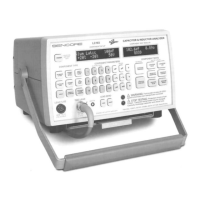
Do you have a question about the Sencore ReZolver LC103 and is the answer not in the manual?
| Category | Measuring Instruments |
|---|---|
| Display Type | LCD |
| Power Supply | AC Adapter or Battery |
| Dimensions | 10.5 x 7.5 x 3.5 inches |
| Accuracy | 0.1% |
| Measurement Type | L, C, R |
| Display | LCD |
Explains the meaning of various symbols used in the manual and on the equipment.
Provides a general overview of capacitors and inductors in electronic systems and the LC103's role.
Highlights the LC103 ReZolver's dynamic, portable, and automatic testing capabilities for capacitors and inductors.
Details the dynamic in-circuit testing capabilities for capacitors and inductors, including ranges and accuracies.
Covers out-of-circuit capacitor testing for value, leakage, ESR, and dielectric absorption, with specific parameters.
Details out-of-circuit inductor testing for value and quality using patented Ringer test, including ranges and accuracies.
Describes the patented Ringer test for inductor quality by counting ringing cycles before damping.
Lists general specifications such as operating temperature, humidity, altitude, power, dimensions, weight, and indications.
Allows connection to a computer for automated operation via an RS-232 interface.
Connects to the power adapter for AC operation and battery charging.
Patent-pending probe with width adjustment wheel and test activation switch for in-circuit testing.
A lead acid battery providing portable operation for the LC103 unit.
Extends LC103 test capabilities to test SCRs and TRAICS.
Details how to operate the LC103 using an AC power adapter for bench operation.
Describes the built-in battery test feature that indicates the remaining battery charge.
Explains the auto-off circuit that conserves battery charge by powering down the unit if idle.
Locates the 1 amp, Slo-Blo fuse on the front panel that protects the unit from overloads.
Provides instructions on how to safely replace the test lead fuse with the correct type and rating.
Details the procedure for zeroing test leads and probes to compensate for impedance before testing.
Explains how to perform basic in-circuit capacitor tests for value and ESR.
Describes how to perform automatic GOOD/BAD tests by entering component parameters for comparison.
Explains the "SUGGEST REMOVAL" message and when a component may need removal for accurate testing.
Details the procedure for measuring capacitor value out-of-circuit, including polarity considerations.
Explains how to test capacitors for excessive Equivalent Series Resistance (ESR) and compare to standards.
Covers testing for dielectric absorption, a measure of a capacitor's memory effect, and how to interpret results.
Details the procedure for measuring capacitor leakage current at rated voltage, displaying results in uA and Ohms.
Explains how to perform automatic GOOD/BAD inductor value tests by programming tolerance and marked value.
Describes the patented Ringer test for checking inductor quality (Q factor) and detecting shorted turns.
Details how to measure inductor value out-of-circuit using the LC103, including notes on open components.
Explains how to connect the LC103 to a computer using an RS-232 cable for automated testing.
Describes how the LC103 accepts commands from a computer to select functions or send parameters.
Lists listener codes for entering component data, including value multipliers and component type commands.
Explains how the LC103 sends test results back to a computer via RS-232, detailing data format.
Defines the standard 17-character data string format returned by the LC103, including header, data, and indicator fields.
Advises computer software to test for error conditions returned by the LC103 to ensure reliable operation.
Describes how the LC103 detects shorted capacitors, indicated by "SHT" or "SHORT" messages.
Provides guidance on performing leakage tests on large capacitors, noting that multiple readings may be needed.
Discusses potential errors in ESR testing and conditions to check, like minimum capacitance and lead zeroing.
Explains how to identify different capacitor types based on physical characteristics for accurate testing.
Describes aluminum electrolytic capacitors, their construction, common failure modes, and identification.
Details tantalum electrolytic capacitors, their advantages over aluminum lytics, and identification methods.
Describes ceramic capacitors, their variety, common types like discs, and temperature characteristics.
Covers capacitors not fitting other categories, such as films, micas, and air, and their testing requirements.
Describes yokes and flybacks used in video applications, their construction, and testing with the Ringer test.
Covers non-iron core inductors not classified elsewhere, including RF chokes and axial lead inductors.
Discusses capacitor testing, including measurement accuracy and testing small values in noisy environments.
Guides users on interpreting capacitor value readings, including conversion between units and understanding manufacturer markings.
Explains the process and logic of the in-circuit capacitor test, including parallel component checks and default settings.
Discusses how capacitor values can change due to poor connections, thermal stress, or cracks, affecting performance.
Explains excessive ESR as a common capacitor problem that generates heat and reduces filtering capability.
Describes capacitor leakage as a common failure mode caused by current through the dielectric, necessitating testing at rated voltage.
Explains dielectric absorption, or "capacitor memory," as a failure mode that can affect circuit bias levels.
Outlines the Sencore Service Department's capabilities for in and out-of-warranty service and recalibration.
Provides instructions for properly packing the unit for return shipment to the Sencore factory for repair.
